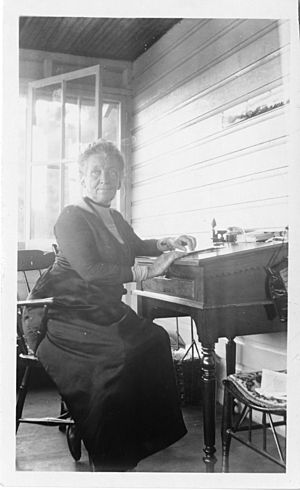Cornelia Clapp facts for kids
Quick facts for kids
Cornelia Maria Clapp
|
|
|---|---|

Cornelia Maria Clapp sitting at desk – Gardiner Road cottage in Woods Hole, MA
|
|
| Born | March 17, 1849 |
| Died | December 31, 1934 (aged 85) |
| Citizenship | American |
| Alma mater | Syracuse University, University of Chicago |
| Known for | marine biology |
| Scientific career | |
| Fields | Biology, zoology |
| Institutions | Mount Holyoke College, Marine Biological Laboratory |
Cornelia Maria Clapp (born March 17, 1849 – died December 31, 1934) was an amazing American zoologist and teacher. She was an expert in marine biology, which is the study of ocean life. Born in Montague, Massachusetts, she was considered one of the best zoologists in the United States during her time.
Cornelia Clapp made history by earning the first two Ph.D. degrees ever given to women in the U.S. She got one from Syracuse University in 1889 and another from the University of Chicago in 1896. Today, the Cornelia Clapp Laboratory at Mount Holyoke College is named in her honor. It was built in 1924 for biology classes.
Contents
Cornelia's Education and Career
Cornelia finished her studies at Mount Holyoke Female Seminary in 1871. This school later became Mount Holyoke College. After graduating, she taught Latin for a year at a boys' school in Pennsylvania.
In 1872, she returned to Mount Holyoke. She taught math and natural history. Later, she even became the college's gymnastics instructor!
Learning from Nature
Cornelia loved to learn. In 1874, she studied at the Anderson School of Natural History. This school was on Penikese Island in Buzzard's Bay, Massachusetts. She learned from a famous scientist named Louis Agassiz. He taught her to "Study nature, not books!" Cornelia used this idea in her own teaching.
She brought new ideas to Mount Holyoke. For example, she taught a course on embryology. This is the study of how living things develop before birth. She even got specimens from former students who traveled abroad.
Cornelia also loved collecting insects. In 1875, she collected insects in the White Mountains of New Hampshire. In 1877, she collected more in the mid-Atlantic states. She visited places like the Johns Hopkins University marine station and the Smithsonian Institution.
Advanced Studies and Research
In the early 1880s, Cornelia studied chick embryos and earthworms. She did this at the Massachusetts Institute of Technology and Williams College.
Starting in 1888, Cornelia worked at the Marine Biological Laboratory (MBL) in Woods Hole, Massachusetts. This is a very important place for marine science. In 2021, the MBL renamed its main lecture hall the Cornelia Clapp Auditorium to honor her. At MBL, Cornelia did research and became a lecturer and a trustee. Her important paper about toadfish was published in 1889.
When Mount Holyoke became a college in 1888, Cornelia took time off. She went to the University of Chicago to get her doctorate degree. When she came back, she helped create the zoology department. In 1904, she became a professor of zoology. Even though she didn't write many scientific papers, she was known as a great teacher. In 1906, a science journal named her one of the 150 most important zoologists in the U.S.
Marine Biological Laboratory Contributions
Cornelia Clapp was the first female researcher at the Marine Biological Laboratory (MBL). She also worked as the librarian and a trustee. She was involved with MBL from its very beginning in 1888 until she passed away in 1934.
She helped a lot to set up the new MBL. She was one of the first students there in 1888. Cornelia strongly believed that Woods Hole needed a good library. She wanted it to have subscriptions to the best science journals. So, she became the first MBL librarian. She started a program where MBL sent out its Biological Bulletin journal. In return, they received other international journals. Over time, this built an amazing collection of books and papers.
In 1910, Cornelia was chosen to be on the MBL Board of Trustees. She was one of only two women to be elected to this board for the next 50 years. This was a very important position. In 2021, the MBL honored her again by naming their main lecture hall the Cornelia Clapp Auditorium.
Cornelia Clapp's Legacy
Cornelia Clapp lived at a time when science was just starting to open up for women. Her impact as a teacher was huge and lasted a long time. She didn't publish many research papers. Instead, her main goal was to share scientific knowledge and opportunities with women through education.
Her teaching style was very direct and inspiring. One of her students, Louise Baird Wallace, came to Mount Holyoke in 1891. Her old principal told her, "You should study with Dr. Clapp. She keeps live frogs in tanks!" Louise later wrote about Cornelia, "I came, I saw; she conquered. I felt then and have felt ever since that I was never fully alive until I knew her."
Images for kids
See also
 In Spanish: Cornelia Clapp para niños
In Spanish: Cornelia Clapp para niños


